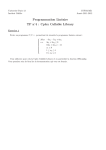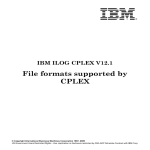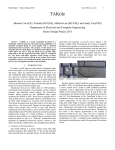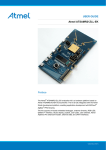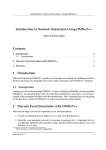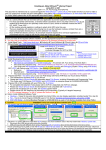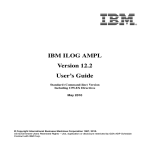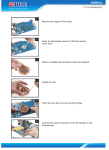Download MPS File Format
Transcript
Inside of the square brackets, two variables are multiplied by an asterisk (*). For example, [4x*y] indicates that the coefficients of both of the off-diagonal terms of Q, corresponding to the variables x and y in the model are 2, since 4x*y equals 2x*y + 2x*y. Each pair of off-diagonal terms of Q is specified only once. ILOG CPLEX automatically creates both off-diagonal entries of Q. Diagonal terms in Q (that is, terms with an exponent of 2) are indicated by the caret (^) followed by 2. For example, 4x^2 indicates that the coefficient of the diagonal term of Q corresponding to the variable x in the model is 4. For example, this problem Minimize a + b + 1/2(a2 + 4ab +7b2) subject to a + b ≥ 10 and a, b ≥ 0 in LP format looks like this: Minimize obj: a + b + [ a^2 + 4 a * b + 7 b^2 ]/2 Subject To c1: a + b >= 10 End 18. This rule is of interest only to advanced users. It is possible to include pools of lazy constraints and user defined cuts in an LP file. A pool of lazy constraints or of user defined cuts must not contain any quadratic constraints. For more about these concepts, see User-Cut and Lazy-Constraint Pools on page 377 in the ILOG CPLEX User’s Manual. MPS File Format MPS format, long established on mainframe LP systems, has become a widely accepted standard for defining LP problems. In contrast to the ILOG CPLEX LP format, MPS format is a column-oriented format: problems are specified by column (variable) rather than by row (constraint). ILOG CPLEX Extensions to MPS Format Historically, MPS format (including CPLEX MPS format for CPLEX version 2.1 and earlier releases) included restrictions, such as requiring input fields to occupy fixed columnar positions and limiting all names to a length of 8 characters or fewer. In CPLEX version 3.0 and subsequent releases, these restrictions were relaxed. The current ILOG CPLEX MPS format is actually an extended version of the historical MPS format. To allow for these extensions, certain practices which were accepted in MPS files for older CPLEX releases and other systems are no longer permitted. For example, since ILOG CPLEX no longer requires fixed columnar positions, blank spaces are interpreted as delimiters. Older MPS 14 ILOG CPLEX 10.0 — FIL E F ORMAT RE FERENCE M ANUAL MPS File Format files containing names with embedded spaces therefore become unreadable. To maintain compatibility with earlier versions as well as MPS files from other systems, ILOG CPLEX provides an MPS file conversion utility which translates older files into the newer ILOG CPLEX MPS format. The section Converting File Formats on page 140 in the ILOG CPLEX User’s Manual explains how to use the file conversion utility. Records in MPS Format MPS data files are analogous to a deck of computer input cards: each line of the MPS file represents a single card record. Records in an MPS data file consist of two types: indicator records and data records. The records contain fields delimited by blank spaces. Indicator Records Indicator records separate the individual sections of the MPS file. Each indicator record contains a single word that begins in the first column. There are seven kinds of indicator records, each corresponding to sections of the MPS file. They are listed in Table 1. Table 1 Indicator records Section name/indicator record Purpose NAME specifies the problem name; unlike other indicator records, the name record contains data ROWS specifies name and sense for each constraint COLUMNS specifies the name assigned to each variable (column) and the nonzero constraint coefficients corresponding to that variable RHS specifies the names of righthand side vectors and values for each constraint (row) RANGES specifies constraints that are restricted to lie in the interval between two values; interval endpoints are also specified BOUNDS specifies the limits within which each variable (column) must remain ENDATA signals the end of the data; always the last entry in an MPS file Each section of the MPS file except the RANGES and BOUNDS sections is mandatory. If no BOUNDS section is present, all variables have their bounds set from 0 (zero) to +∞ (positive infinity). Failure to include an RHS section causes ILOG CPLEX to generate a warning message and set all righthand side values to 0 (zero). Variables and constraints must be ILOG CPLEX 10.0 — FIL E F ORMAT RE FERENCE M ANUAL 15 declared in the ROWS and COLUMNS sections before they are referenced in the RHS, RANGES, and BOUNDS sections. Data Records Data records contain the information that describes the LP problem. Each data record comprises six fields, as in Table 2. The fields must be separated by white space (that is, blank space, tab, etc.), and the first field must begin in column 2 or beyond. Not all fields are used within each section of the input file. Table 2 Fields of a data record in MPS file format Contents Field 1 Field 2 Field 3 Field 4 Field 5 Field 6 Indicator Name Name Value Name Value Any ASCII character (32 through 126) is legal, but names must contain no embedded blanks. In addition, names over 255 characters are truncated. CPLEX issues an error message if truncation causes the names to lose their uniqueness. Numeric fields can be at most 25 characters long. If the first character in Field 3 or 5 is a dollar sign ($), the remaining characters in the record are treated as a comment. Another method for inserting comments is to place an asterisk (*) in column 1. Everything on such a line is treated as a comment. Values may be defined with decimal or exponential notation and may utilize 25 characters. In exponential notation, plus (+) and minus (-) signs must precede the exponent value. If an exponent value is missing where one is expected, it is assigned a value of 0 (zero). ROWS Section In the ROWS section, each row of the problem is specified with its name and sense, one row per record. Field 1 contains a single letter designating the sense of each row. Acceptable values are: ● N indicates a free row. ● G indicates a greater-than-or-equal-to row. ● L indicates a less-than-or-equal-to row. ● E indicates an equality row. Field 2 contains a character identifier, maximum length of 255 characters, specifying the name of the row. Fields 3-6 are not used in the ROWS section. If more than one free row is specified, the first one is used as the objective function and the others are discarded. 16 ILOG CPLEX 10.0 — FIL E F ORMAT RE FERENCE M ANUAL MPS File Format The ROWS section of our example looks like this: ROWS N obj L c1 L c2 COLUMNS Section In the COLUMNS section, all the columns of the constraint matrix are specified with their name and all of the nonzero elements. Multiple records may be required to completely specify a given column. Field 1: Blank Field 2: Column identifier Field 3: Row identifier Field 4: Value of matrix coefficient specified by Fields 2 and 3 Field 5: Row identifier (optional) Field 6: Value of matrix coefficient specified by Fields 2 and 5 (optional) After a matrix element is specified for a column, all other nonzero elements in that same column should be specified. The COLUMNS section of our example looks like this: COLUMNS x1 x1 x2 x2 x3 x3 obj c2 obj c2 obj c2 -1 1 -2 -3 -3 1 c1 -1 c1 1 c1 1 RHS Section In the RHS section, the nonzero righthand-side values of the constraints are specified. Field 1: Blank Field 2: RHS identifier Field 3: Row identifier Field 4: Value of RHS coefficient specified by Field 2 and 3 Field 5: Row identifier (optional) Field 6: Value of RHS coefficient specified by Field 2 and 5 (optional) Several RHS vectors can exist. The name of each RHS vector appears in Field 2. However, only the first RHS vector is selected when a problem is read. Additional RHS vectors are discarded. ILOG CPLEX 10.0 — FIL E F ORMAT RE FERENCE M ANUAL 17 The RHS section of our example looks like this: RHS rhs c1 20 c2 30 RANGES Section In the RANGES section, RHS range values to be applied to constraints may be specified. Field 1: Blank Field 2: Righthand side range vector identifier Field 3: Row identifier Field 4: Value of the range applied to row specified by Field 3 Field 5: Row identifier (optional) Field 6: Value of the range applied to row specified by Field 5 (optional) The effect of specifying a righthand side range depends on the sense of the specified row and whether the range has a positive or negative coefficient. Table 3 specifies how range values are interpreted. For a given row, rhs is the righthand side value and range is the corresponding range value. Table 3 How range values are interpreted in data records of MPS files Row type Range value sign Resulting rhs upper limit Resulting rhs lower limit G + or - rhs + |range| rhs L + or - rhs rhs - |range| E + rhs + range rhs E - rhs rhs + range The name of each range vector appears in Field 2. More than one range vector can be specified within an MPS file. However, only the first range vector is selected when a problem is read. Additional range vectors are discarded. In our example, there are no ranged rows, but suppose we want to add the following constraint to our problem: x1 - 3x2 + x3 >= 15 Instead of explicitly adding another row to the problem, we can represent this additional constraint by modifying row 2 of the example to make it a ranged row in this way: 15 <= x1 - 3x2 + x3 <= 30 18 ILOG CPLEX 10.0 — FIL E F ORMAT RE FERENCE M ANUAL MPS File Format The RANGES section of the MPS file to support this modification looks like this: RANGES rhs c2 15 The name of each range vector appears in Field 2. However, only the first range vector is selected when a problem is read. Additional range vectors are discarded. BOUNDS Section In the BOUNDS section, bound values for variables may be specified. Field 1: Type of bound. Acceptable values are: ● LO Lower bound ● UP Upper bound ● FX Fixed value (upper and lower bound the same) ● FR Free variable (lower bound -∞ and upper bound +∞) ● MI Minus infinity (lower bound = -∞) ● PL Plus infinity (upper bound = +∞) Field 2: Bound identifier Field 3: Column identifier to be bounded Field 4: Value of the specified bound Fields 5 and 6 are not used in the BOUNDS section. In our example, the BOUNDS section looks like this: BOUNDS UP BOUND x1 40 If no bounds are specified, ILOG CPLEX assumes a lower bound of 0 (zero) and an upper bound of +∞. If only a single bound is specified, the unspecified bound remains at 0 or +∞, whichever applies, with one exception. If an upper bound of less than 0 is specified and no other bound is specified, the lower bound is automatically set to -∞. ILOG CPLEX deviates slightly from a convention used by some MPS readers when it encounters an upper bound of 0 (zero). Rather than automatically set this variable’s lower bound to -∞, ILOG CPLEX accepts both a lower and upper bound of 0, effectively fixing that variable at 0. ILOG CPLEX resets the lower bound to -∞ only if the upper bound is less than 0. A warning message is issued when this exception is encountered. More than one bound vector may exist. The name of each bound vector appears in Field 2. However, only the first bound vector is selected when a problem is read. Additional bound vectors are discarded. ILOG CPLEX 10.0 — FIL E F ORMAT RE FERENCE M ANUAL 19 Complete Example of MPS File Format NAME ROWS N obj L c1 L c2 COLUMNS x1 x1 x2 x2 x3 x3 RHS rhs BOUNDS UP BOUND ENDATA example2.mps obj c2 obj c2 obj c2 -1 1 -2 -3 -3 1 c1 -1 c1 1 c1 1 c1 20 c2 30 x1 40 Special Records in MPS Files: ILOG CPLEX Extensions ILOG CPLEX extends the MPS standard in several ways. The following sections document these extensions: ◆ Objective Sense and Name in MPS Files on page 20 ◆ Integer Variables in MPS Files on page 21 ◆ Special Ordered Sets (SOS) in MPS Files on page 23 ◆ Quadratic Objective Information in MPS Files on page 25 ◆ Quadratically Constrained Programs (QCP) in MPS Files on page 27 ◆ Indicator Constraints in MPS Files on page 27 ◆ User Defined Cuts in MPS Files on page 28 ◆ Lazy Constraints in MPS Files on page 29 Objective Sense and Name in MPS Files ILOG CPLEX extends the MPS standard by allowing two additional sections: OBJSEN and OBJNAME. They may be specified after the NAME section. OBJSEN sets the objective function sense, and OBJNAME selects an objective function from among the free rows within the file. If neither of these sections appears in the MPS file, ILOG CPLEX assumes that the problem is a minimization and that the objective function is the first free row encountered in the ROWS section. If these options are used, they must appear in order and as the first and second sections after the NAME section. The values for OBJSENSE can be MAX or MIN. 20 ILOG CPLEX 10.0 — FIL E F ORMAT RE FERENCE M ANUAL MPS File Format Here is an example of these optional sections: NAME OBJSENSE MAX OBJNAME rowname example.mps Integer Variables in MPS Files If you use the ILOG CPLEX mixed integer optimizer, then you may restrict any or all variables to integer values. ILOG CPLEX accepts two commonly used ways of extending the MPS file format to include integer variables: in the COLUMNS section or in the BOUNDS section. In the first way, integer variables are identified within the COLUMNS section of the MPS file by marker lines. A marker line is placed at the beginning and end of a range of integer variables. Multiple sets of marker lines are allowed. Integer marker lines have a field format consisting of Fields 2 through 4. Field 2: Marker name Field 3: 'MARKER' (including the single quotation marks) Field 4: Keyword 'INTORG' and 'INTEND' to mark beginning and end respectively (including the single quotation marks) Fields 5 and 6 are ignored. The marker name must differ from the preceding and succeeding column names. If no bounds are specified for the variables within markers, bounds of 0 (zero) and 1 (one) are assumed. ILOG CPLEX 10.0 — FIL E F ORMAT RE FERENCE M ANUAL 21 In the following example, column x4 is an integer variable and looks like this in the COLUMNS section of an MPS file, according to this first way of treating integer variables: NAME ROWS N obj L c1 L c2 E c3 COLUMNS x1 x1 x2 x2 x3 x3 MARK0000 x4 x4 MARK0001 RHS rhs BOUNDS UP BOUND LO BOUND UP BOUND ENDATA obj c2 obj c2 obj c2 ‘MARKER’ obj c3 ‘MARKER’ -1 1 -2 -3 -3 1 -1 -3.5 c1 -1 c1 c3 c1 1 1 1 ‘INTORG’ c1 10 ‘INTEND’ c1 20 x1 x4 x4 40 2 3 c2 30 In the second way of treating integer variables, integer variables are declared in the BOUNDS section with special bound types in Field 1. The acceptable special bound types appear in Table 4. Table 4 Special bound types for handling integer variables in MPS files Type Purpose Special Considerations BV Binary variable Field 4 must be 1.0 or blank LI Integer lower bound Field 4 is the lower bound value and must be an integer SC Semi-continuous variable Field 4 is the upper bound and must be specified UI Integer upper bound Field 4 is the upper bound value and must be an integer To specify general integers with no upper bounds, use LI with the value 0.0. 22 ILOG CPLEX 10.0 — FIL E F ORMAT RE FERENCE M ANUAL MPS File Format For example, column x4 is an integer variable declared in the BOUNDS section of an MPS file, according to this second way of treating integer variables: NAME ROWS N obj L c1 L c2 E c3 COLUMNS x1 x1 x2 x2 x3 x3 x4 x4 RHS rhs BOUNDS UP BOUND LI BOUND UI BOUND ENDATA obj c2 obj c2 obj c2 obj c3 -1 1 -2 -3 -3 1 -1 -3.5 c1 -1 c1 c3 c1 1 1 1 c1 10 c1 20 c2 30 x1 x4 x4 40 2 3 Special Ordered Sets (SOS) in MPS Files If you use the ILOG CPLEX mixed integer optimizer (that is, the MIP optimizer), then you may define special ordered sets (SOS) in MPS format. The convention for SOS uses set declaration lines and member declaration lines, both of which begin in column 2 or beyond. In a set declaration line, columns 2 and 3 specify S1 or S2. Optionally, the name of a set is specified in column 4. In a member declaration line, column 5 or beyond specifies a variable name. Note that in an MPS file, the SOS section must follow the BOUNDS section. If weighting information is to be provided, it is after the member name in a member declaration line. ILOG CPLEX 10.0 — FIL E F ORMAT RE FERENCE M ANUAL 23 In the following example, an SOS section is placed after the BOUNDS section: NAME ROWS N obj L c1 L c2 E c3 COLUMNS x1 x1 x2 x2 x3 x3 x4 x4 RHS rhs BOUNDS UP BOUND LI BOUND UI BOUND SOS S1 set1 x1 x2 x4 x5 ENDATA obj c2 obj c2 obj c2 obj c3 -1 1 -2 -3 -3 1 -1 -3.5 c1 -1 c1 c3 c1 1 1 1 c1 10 c1 20 c2 30 x1 x4 x4 40 2 3 10000 20000 40000 50000 'MARKER' Lines for SOS in MPS Files 'MARKER' lines are used to delimit SOS in the COLUMNS section of an MPS file, much like using integer markers. (The single quotation mark before and after the term is necessary.) The names of the sets are specified in the second field, starting in column 4 or beyond. Names of sets must be unique. The 'MARKER' lines must come in pairs of an 'SOSORG' and 'SOSEND' surrounding the columns that are in the SOS. Optionally, in Field 1 of a 'MARKER' . . . 'SOSORG' line, either S1 or S2 may be specified to indicate the type of the SOS. An SOS 'MARKER' line without an S1 or S2 indicator is assumed to denote an S1 set. Members of an SOS may or may not be integer or binary variables. There is no requirement that there be a constraint that all members of an SOS sum to 1.0 (nor is any such constraint implicit). However, providing such a constraint in your formulation may be desirable as it may strengthen the LP relaxation of the mixed integer problem, as for example in the case of an S1 set consisting of binary variables. 24 ILOG CPLEX 10.0 — FIL E F ORMAT RE FERENCE M ANUAL MPS File Format In the following example, the excerpt from the COLUMNS section of an MPS file defines an SOS Type 1 set consisting of x5 and x6. which may be continuous or integer variables. S1 NAME1 x5 x5 x6 x6 NAME2 ‘MARKER’ obj c2 obj c3 ‘MARKER’ -9 3 -6 -4.5 ‘SOSORG’ c1 5 c1 8 ‘SOSEND’ The SOS 'MARKER' lines can appear between integer 'MARKER' lines (if all members of the SOS are integer), or integer 'MARKER' lines can appear between SOS 'MARKER' lines (if some members of the SOS are non-integer). The MARKER format cannot accommodate overlapping SOSs. That is, a variable cannot be a member of two special ordered sets. Overlapping SOSs can, however, be specified by the ILOG CPLEX SOS format, documented in Special Ordered Sets (SOS) in MPS Files on page 23. REFROW Section for SOS in MPS Files A REFROW section may be included immediately before the ROWS section. It consists of exactly one record line with the name of the reference row starting in Field 2. The specified row must also be defined in the ROWS section. The nonzeros of the reference row are used as weights within an SOS. All weights within one SOS must be unique values. A REFROW section is optional; if no reference row is specified, the weighting values 1, . . . , n is given to the n members of an SOS in the order in which they are read. In other words, without specific reference row information, it is assumed that the user has ordered the SOS variables in ascending order with respect to some relevant criterion (for example, in importance, capacity, objective weighting, or cost). Quadratic Objective Information in MPS Files If you use the ILOG CPLEX barrier optimizer for quadratic programming problems (QPs), then you can specify quadratic objective coefficients in MPS format in a QMATRIX section. Following the BOUNDS section, a QMATRIX section may be specified. Each line of this section defines one nonzero coefficient of the matrix Q. Each line should contain two variable names (which must have been specified in the COLUMNS section) in Fields 2 and 3, followed by a nonzero coefficient value in Field 4. For each off-diagonal coefficient, two lines must appear: one for the lower triangular element, and one for the upper triangular element. ILOG CPLEX evaluates the quadratic part of the objective function as 0.5 x'Qx, when the coefficients of Q are specified in an MPS file. ILOG CPLEX 10.0 — FIL E F ORMAT RE FERENCE M ANUAL 25 For example, consider the following problem: Minimize a + b + 1/2 a + b ≥ 10 a, b ≥ 0 (a2 + 4ab + 7b2) subject to In MPS format, you may enter the problem in the following way: NAME ROWS N obj G c1 COLUMNS a b RHS rhs QMATRIX a a b b ENDATA problem obj obj 1 1 c1 10 a b a b 1 2 2 7 c1 c1 1 1 You can also enter the quadratic objective coefficients by using a QUADOBJ section. In this format, only the upper diagonal elements of the Q matrix are entered. For the same example, the input with a QUADOBJ section looks like this: NAME ROWS N obj G c1 COLUMNS a b RHS rhs QUADOBJ a a b ENDATA problem obj obj 1 1 c1 10 a b b 1 2 7 c1 c1 1 1 If you have a model with quadratic objective information in MPS format in a QUADOBJ section of the following form, you do not have to convert your file in order for ILOG CPLEX to make use of it. varname1 varname2 value 26 ILOG CPLEX 10.0 — FIL E F ORMAT RE FERENCE M ANUAL MPS File Format ILOG CPLEX can read that file and interpret the QUADOBJ section correctly. However, the MPS file writers of ILOG CPLEX do not produce a QUADOBJ section themselves. Instead, they produce a QMATRIX section, as explained here. Quadratically Constrained Programs (QCP) in MPS Files As explained in the ILOG CPLEX User’s Manual in Solving Problems with Quadratic Constraints (QCP) on page 225, ILOG CPLEX can solve problems with quadratic terms among the constraints if the Q matrix for the quadratic term is positive semi-definite and the quadratic function defines a convex region. ILOG CPLEX has extended the MPS format to accommodate QCP models. The quadratic constraints of such a model are listed in the ROWS section, and their linear coefficients appear in the COLUMNS section, just the same as coefficients from the linear constraints. The quadratic terms go in QCMATRIX sections, one QCMATRIX per quadratic constraint. QCMATRIX sections appear after the optional SOS section. They may appear either after or before the QMATRIX (objective) section. The name of the constraint appears on the same line after QCMATRIX. The quadratic terms of the quadratic expression must be given as a symmetric matrix. That is, if there is an entry for Qij, then there must be an identical entry for Qji when i is not equal to j. This requirement is the same as for the QMATRIX section, where any quadratic terms in the objective function are declared. The formats of the Q parts are the same. Indicator Constraints in MPS Files Indicator constraints provide a way for you to express relations among variables by identifying a binary (0-1) variable to control whether or not a given constraint is active. ILOG CPLEX has extended the MPS format to express indicator constraints. The constraints to be controlled by the binary variable are listed in the ROWS section; their linear coefficients appear in the COLUMNS section (that is, the same as coefficients from linear constraints). Only rows of types E, L, and G may be part of indicator constraints. In other words, a row of type N cannot appear as a constraint controlled by a binary variable in this sense (that is, an indicator constraint). The binary variables that control the linear constraints are specified in the BOUNDS section or with MARKER lines (that is, like any other binary variable). The relationship between the binary variables and the constraints they control is specified in the INDICATORS section. The INDICATORS section follows any quadratic constraint section and any quadratic objective section. Each line of the INDICATORS section has a type field starting in column 2 or beyond; the type must be "IF" followed by the name of the row of the indicator constraint, the name of the binary variable, and finally the value 0 (zero) or 1 (one) to indicate when the constraint should be active. ILOG CPLEX 10.0 — FIL E F ORMAT RE FERENCE M ANUAL 27 Rows that appear in the INDICATORS section cannot be ranged rows. In other words, a row that appears in the RANGES section cannot appear also in the INDICATORS section. Here is an example of an INDICATORS section: NAME ROWS N obj L row2 L row4 E row1 E row3 COLUMNS x x x x y z z RHS rhs rhs BOUNDS UI bnd INDICATORS IF row1 IF row3 ENDATA ind1.mps obj row2 row4 row1 row4 row4 row3 -1 1 1 1 1 1 1 row2 row4 10 15 y 1 y y 1 0 That declaration represents the following model: Minimize obj: - x Subject To row2: x <= 10 row4: x + y + z <= 15 row1: y = 1 -> x = 0 row3: y = 0 -> z = 0 Bounds 0 <= y <= 1 Binaries y End User Defined Cuts in MPS Files The advanced feature user defined cuts can be declared in a special section following the ROWS section. The title of this section is USERCUTS. The order of sections must be ROWS USERCUTS. The format of the USERCUTS section is the same as the format of the ROWS section with this exception: the type must be one of E, L, or G; the row must not be ranged. For more information about user defined cuts, see User-Cut and Lazy-Constraint Pools on page 377 in the ILOG CPLEX User’s Manual. 28 ILOG CPLEX 10.0 — FIL E F ORMAT RE FERENCE M ANUAL NET File Format Lazy Constraints in MPS Files The advanced feature lazy constraints can be declared in a special section following the ROWS and USERCUTS sections. The title of this section is LAZYCONS. The order of sections must be ROWS USERCUTS LAZYCONS. The format of the LAZYCONS section is the same as the format of the ROWS section with this exception: the type must be one of E, L, or G; the row must not be ranged. For more information about lazy constraints and an example of an MPS file extended to include them, see User-Cut and Lazy-Constraint Pools on page 377 in the ILOG CPLEX User’s Manual. NET File Format The NET file format is an ASCII file format specific to ILOG CPLEX for network-flow problems. It is the recommended file format for representing pure network problems within CPLEX. This format is supported by Concert Technology, by the Callable Library, and by the Interactive Optimizer. In particular, it works with CPXNETptr objects (not CPXLPptr objects). Comments This is a free-format file; that is, line breaks or column positions are irrelevant to the interpretation of the file. The only exceptions to this convention are comments: anything from a backslash (\) character to the end of a line is a comment and does not contribute to the network specified by the file. Comments are allowed anywhere in the file. Keywords The NET format recognizes the following keywords in a file: ● MAXIMIZE ● MINIMIZE ● NETWORK ● ENDNETWORK ● SUPPLY ● DEMAND ● ARCS ● BOUNDS ● OBJECTIVE ● INFINITY ● FREE ILOG CPLEX 10.0 — FIL E F ORMAT RE FERENCE M ANUAL 29


















